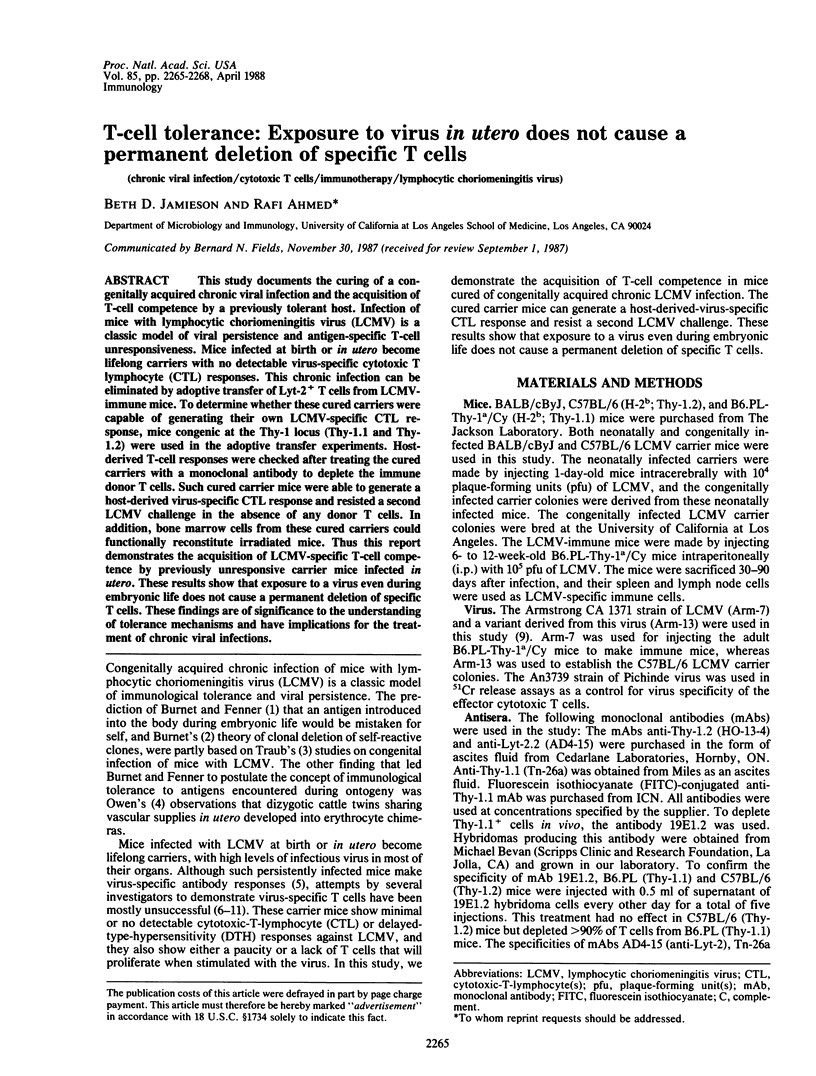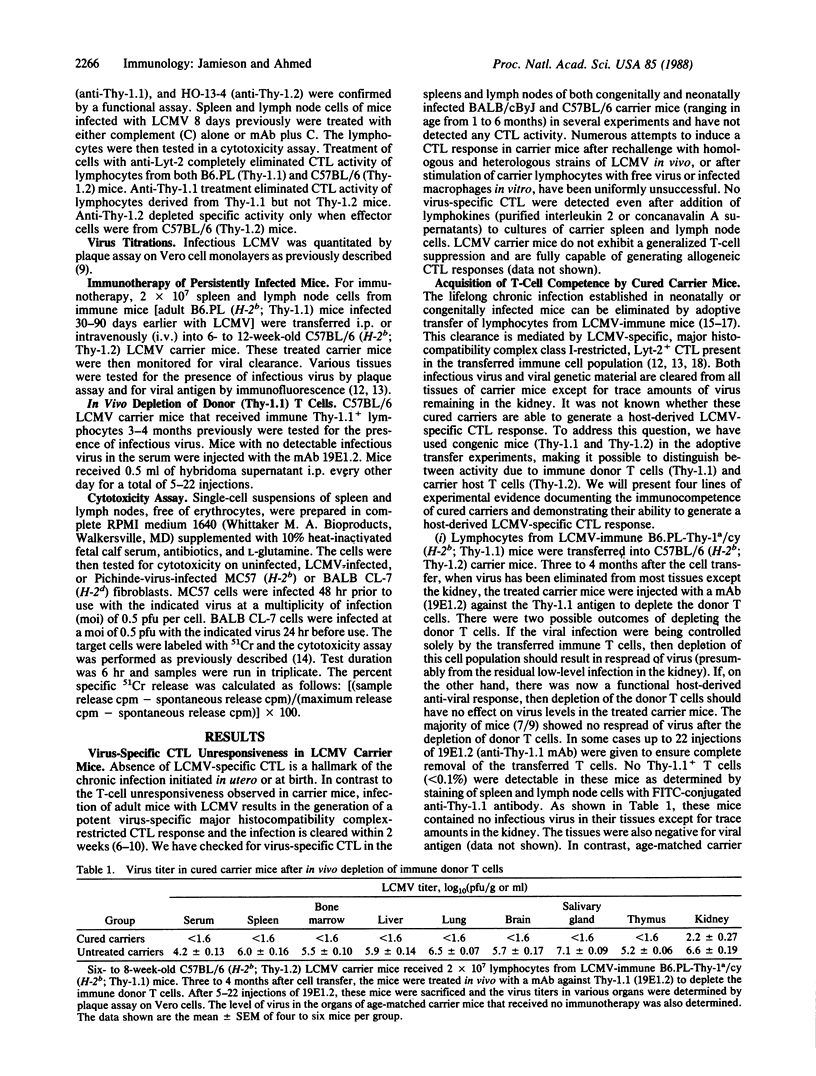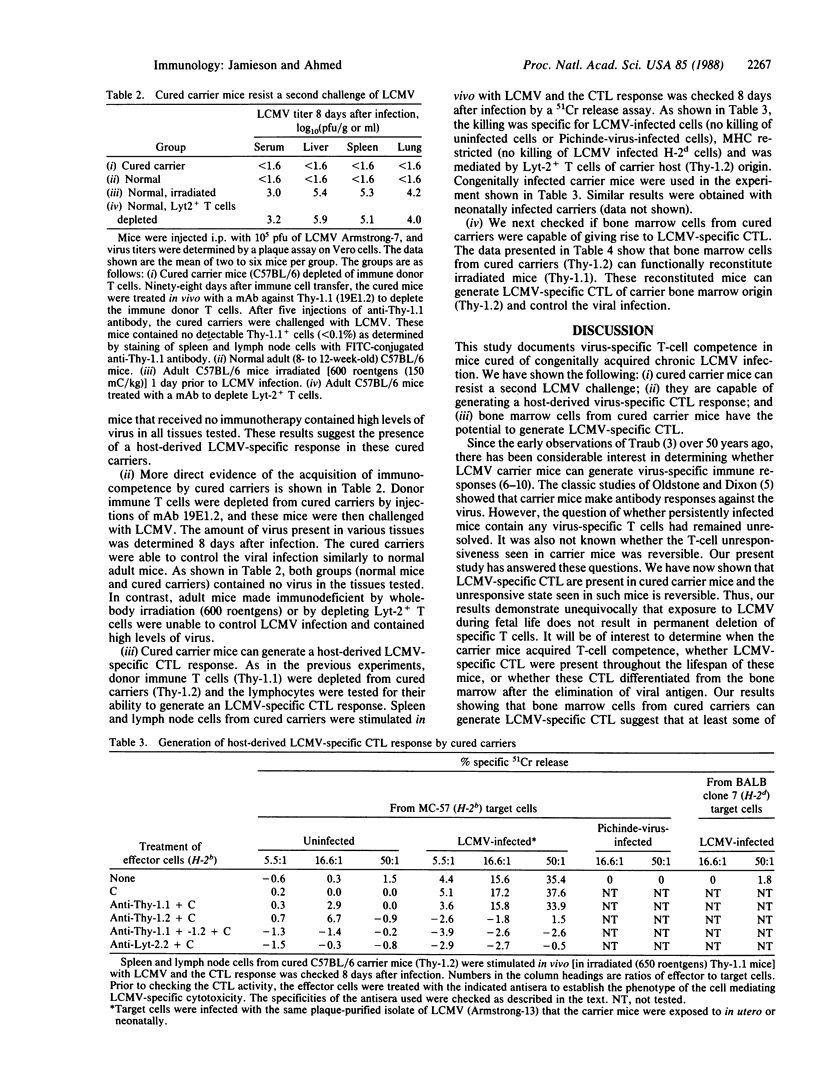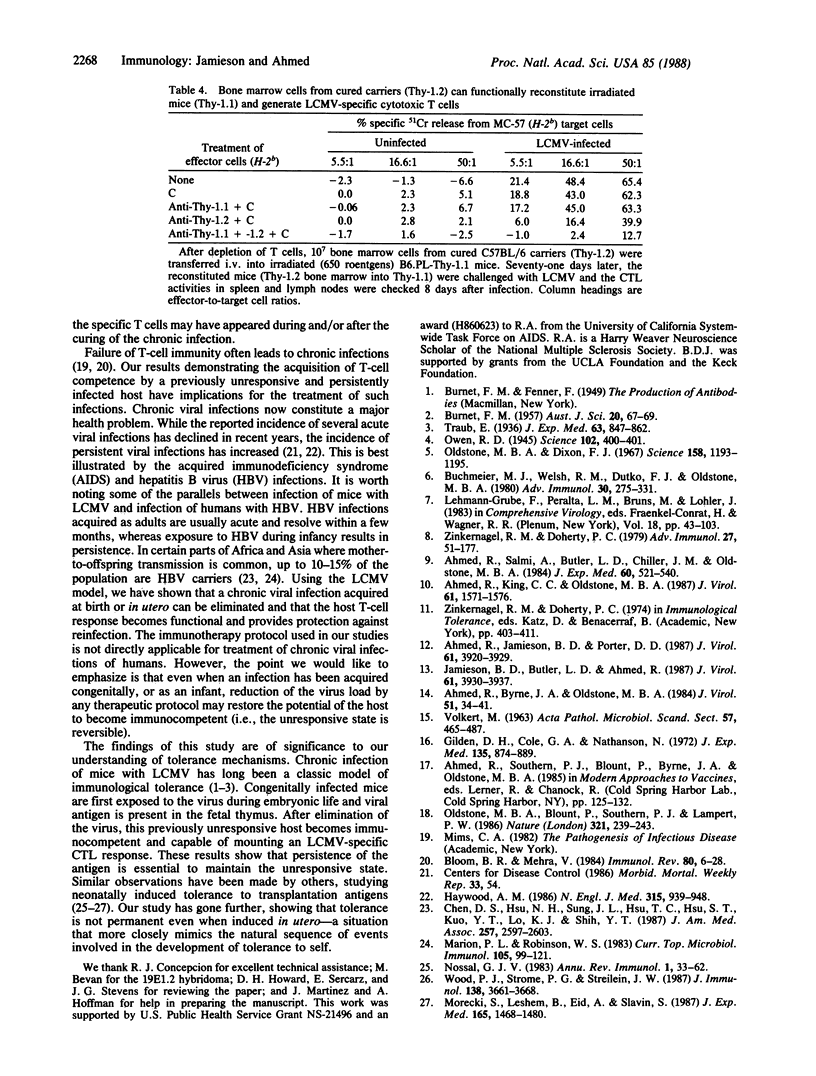Abstract
This study documents the curing of a congenitally acquired chronic viral infection and the acquisition of T-cell competence by a previously tolerant host. Infection of mice with lymphocytic choriomeningitis virus (LCMV) is a classic model of viral persistence and antigen-specific T-cell unresponsiveness. Mice infected at birth or in utero become lifelong carriers with no detectable virus-specific cytotoxic T lymphocyte (CTL) responses. This chronic infection can be eliminated by adoptive transfer of Lyt-2+ T cells from LCMV-immune mice. To determine whether these cured carriers were capable of generating their own LCMV-specific CTL response, mice congenic at the Thy-1 locus (Thy-1.1 and Thy-1.2) were used in the adoptive transfer experiments. Host-derived T-cell responses were checked after treating the cured carriers with a monoclonal antibody to deplete the immune donor T cells. Such cured carrier mice were able to generate a host-derived virus-specific CTL response and resisted a second LCMV challenge in the absence of any donor T cells. In addition, bone marrow cells from these cured carriers could functionally reconstitute irradiated mice. Thus this report demonstrates the acquisition of LCMV-specific T-cell competence by previously unresponsive carrier mice infected in utero. These results show that exposure to a virus even during embryonic life does not cause a permanent deletion of specific T cells. These findings are of significance to the understanding of tolerance mechanisms and have implications for the treatment of chronic viral infections.
Full text
PDF



Selected References
These references are in PubMed. This may not be the complete list of references from this article.
- Ahmed R., Byrne J. A., Oldstone M. B. Virus specificity of cytotoxic T lymphocytes generated during acute lymphocytic choriomeningitis virus infection: role of the H-2 region in determining cross-reactivity for different lymphocytic choriomeningitis virus strains. J Virol. 1984 Jul;51(1):34–41. doi: 10.1128/jvi.51.1.34-41.1984. [DOI] [PMC free article] [PubMed] [Google Scholar]
- Ahmed R., Jamieson B. D., Porter D. D. Immune therapy of a persistent and disseminated viral infection. J Virol. 1987 Dec;61(12):3920–3929. doi: 10.1128/jvi.61.12.3920-3929.1987. [DOI] [PMC free article] [PubMed] [Google Scholar]
- Ahmed R., King C. C., Oldstone M. B. Virus-lymphocyte interaction: T cells of the helper subset are infected with lymphocytic choriomeningitis virus during persistent infection in vivo. J Virol. 1987 May;61(5):1571–1576. doi: 10.1128/jvi.61.5.1571-1576.1987. [DOI] [PMC free article] [PubMed] [Google Scholar]
- Ahmed R., Salmi A., Butler L. D., Chiller J. M., Oldstone M. B. Selection of genetic variants of lymphocytic choriomeningitis virus in spleens of persistently infected mice. Role in suppression of cytotoxic T lymphocyte response and viral persistence. J Exp Med. 1984 Aug 1;160(2):521–540. doi: 10.1084/jem.160.2.521. [DOI] [PMC free article] [PubMed] [Google Scholar]
- Bloom B. R., Mehra V. Immunological unresponsiveness in leprosy. Immunol Rev. 1984 Aug;80:5–28. doi: 10.1111/j.1600-065x.1984.tb00493.x. [DOI] [PubMed] [Google Scholar]
- Buchmeier M. J., Welsh R. M., Dutko F. J., Oldstone M. B. The virology and immunobiology of lymphocytic choriomeningitis virus infection. Adv Immunol. 1980;30:275–331. doi: 10.1016/s0065-2776(08)60197-2. [DOI] [PubMed] [Google Scholar]
- Chen D. S., Hsu N. H., Sung J. L., Hsu T. C., Hsu S. T., Kuo Y. T., Lo K. J., Shih Y. T. A mass vaccination program in Taiwan against hepatitis B virus infection in infants of hepatitis B surface antigen-carrier mothers. JAMA. 1987 May 15;257(19):2597–2603. [PubMed] [Google Scholar]
- Gilden D. H., Cole G. A., Nathanson N. Immunopathogenesis of acute central nervous system disease produced by lymphocytic choriomeningitis virus. II. Adoptive immunization of virus carriers. J Exp Med. 1972 Apr 1;135(4):874–889. doi: 10.1084/jem.135.4.874. [DOI] [PMC free article] [PubMed] [Google Scholar]
- Haywood A. M. Patterns of persistent viral infections. N Engl J Med. 1986 Oct 9;315(15):939–948. doi: 10.1056/NEJM198610093151506. [DOI] [PubMed] [Google Scholar]
- Jamieson B. D., Butler L. D., Ahmed R. Effective clearance of a persistent viral infection requires cooperation between virus-specific Lyt2+ T cells and nonspecific bone marrow-derived cells. J Virol. 1987 Dec;61(12):3930–3937. doi: 10.1128/jvi.61.12.3930-3937.1987. [DOI] [PMC free article] [PubMed] [Google Scholar]
- LIND P. E., BURNET F. M. Recombination between virulent and non-virulent strains of influenza virus. II. The behaviour of virulence markers on recombination. Aust J Exp Biol Med Sci. 1957 Feb;35(1):67–78. doi: 10.1038/icb.1957.8. [DOI] [PubMed] [Google Scholar]
- Marion P. L., Robinson W. S. Hepadna viruses: hepatitis B and related viruses. Curr Top Microbiol Immunol. 1983;105:99–121. doi: 10.1007/978-3-642-69159-1_2. [DOI] [PubMed] [Google Scholar]
- Morecki S., Leshem B., Eid A., Slavin S. Alloantigen persistence in induction and maintenance of transplantation tolerance. J Exp Med. 1987 Jun 1;165(6):1468–1480. doi: 10.1084/jem.165.6.1468. [DOI] [PMC free article] [PubMed] [Google Scholar]
- Nossal G. J. Cellular mechanisms of immunologic tolerance. Annu Rev Immunol. 1983;1:33–62. doi: 10.1146/annurev.iy.01.040183.000341. [DOI] [PubMed] [Google Scholar]
- Oldstone M. B., Blount P., Southern P. J., Lampert P. W. Cytoimmunotherapy for persistent virus infection reveals a unique clearance pattern from the central nervous system. Nature. 1986 May 15;321(6067):239–243. doi: 10.1038/321239a0. [DOI] [PubMed] [Google Scholar]
- Oldstone M. B., Dixon F. J. Lymphocytic choriomeningitis: production of antibody by "tolerant" infected mice. Science. 1967 Dec 1;158(3805):1193–1195. doi: 10.1126/science.158.3805.1193. [DOI] [PubMed] [Google Scholar]
- Owen R. D. IMMUNOGENETIC CONSEQUENCES OF VASCULAR ANASTOMOSES BETWEEN BOVINE TWINS. Science. 1945 Oct 19;102(2651):400–401. doi: 10.1126/science.102.2651.400. [DOI] [PubMed] [Google Scholar]
- VOLKERT M. STUDIES ON IMMUNOLOGICAL TOLERANCE TO LCM VIRUS. 2. TREATMENT OF VIRUS CARRIER MICE BY ADOPTIVE IMMUNIZATION. Acta Pathol Microbiol Scand. 1963;57:465–487. [PubMed] [Google Scholar]
- Wood P. J., Strome P. G., Streilein J. W. Characterization of cytotoxic cells in mice rendered neonatally tolerant of MHC alloantigens: evidence for repertoire modification. J Immunol. 1987 Jun 1;138(11):3661–3668. [PubMed] [Google Scholar]
- Zinkernagel R. M., Doherty P. C. MHC-restricted cytotoxic T cells: studies on the biological role of polymorphic major transplantation antigens determining T-cell restriction-specificity, function, and responsiveness. Adv Immunol. 1979;27:51–177. doi: 10.1016/s0065-2776(08)60262-x. [DOI] [PubMed] [Google Scholar]


